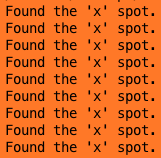
Perl Refreshments ⌘
Regular Expressions #3 - Pattern Modifiers For 'm//' and 's///'
NOTE: My version of Perl is currently 5.18 so any lists of modifiers, quantifiers, etc. may be different from yours.
Continuing our examination of the 'm//' matching operator. We've seen one in the previous page. Here is a list of modifiers for both 'm//' and 's///':
- i - ignore alphabetic case
- x - ignore white space in patterns and allow comments
- g - work globally to perform all possible operations
- ge - don't reset the search pattern after a failed match
- s - let the character '.' match newlines
- m - let embedded '^' and '$' match '\n' newlines
- o - compile the pattern only once
- e - the right-hand side of 's///' is code to evaluate
- ee - the right-hand side of 's///' is a string and will be run as code; return value is evaluated again
Are you getting the sense that regexes are a bit complex?
We don't have examples of all of them, but here are some to give you an idea.
$text="xxxxxxxxx";
while ($text =~ m/x/g) {
print "Found the 'x' spot.\n";
}

$text="Change this to all upper case."; print "Old \$text: $text\n"; $text =~ s/(\w+)/uc($1)/ge; print "New \$text: $text\n";
![]()
I've thrown something new at you - again.
The \w+ is one of special characters mentioned here. We use it here to match a word character (sometimes called a letter).
The new stuff is that first match we put into the back reference $1, which is then put into upper case uc($1).
And since we used the global modifier /g, it executes on ALL previous matches, which in our case is ALL the letters (word characters) in the string.
The e at the very end matches an escape character, which in our case essentially ends the match. Without it, here's what would we would see:
![]()
Back References
As the name implies, a back reference refers to a previous match. Very handy to be able to do this.
For example, HTML is based on tags such as <a to indicate the beginning of an Internet anchor. Most HTML tags must also have a closing tag. In this case </a>.
Word processors work the same way. When you center some text, there are special (hidden) codes inserted around that text to format it that way.
How would a coder check to make sure all his opening HTML anchor tags had a matching closing tag?
Back references can be indicated by a leading dollar sign $ and a digit: $1, $2 ... or by a back-slash \1, \2 ....
$text="<a>Here is an anchor.</A>";
if ($text =~ /<(a)>[\w\s\.]+<\/\1>/i) {
print "\nComplete anchor tag found.\n\n";
}
else {print "\nIncomplete anchor\n\n";}
![]()
However, if there was no closing anchor tag ...
$text="<a>Here is an anchor.";
if ($text =~ /<(a)>[\w\s\.]+<$1>/i) {
print "\nComplete anchor tag found.\n\n";
}
else {print "\nIncomplete anchor\n\n";}
![]()
Note we've used $1 for this reference, and i modifier to catch upper or lower case.
By running something like this on a page of HTML, a coder would see if all the anchor tags were closed.
Regex 4 - tr/// ...